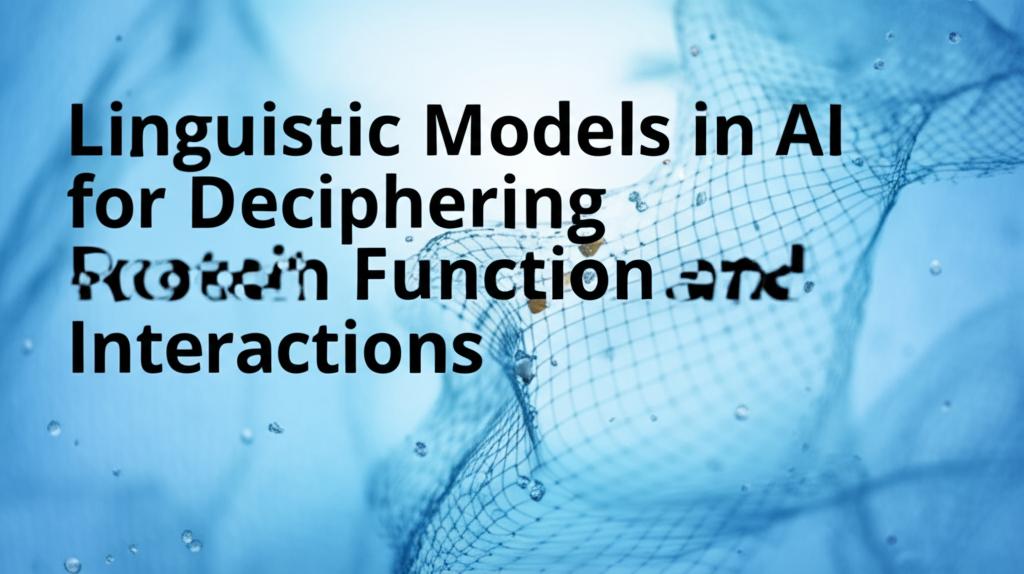The field of protein science is experiencing a revolution, largely driven by the application of linguistic models from artificial intelligence (AI). These models, inspired by how AI understands and processes human language, are proving remarkably adept at deciphering the complex "language" of proteins. This involves understanding their sequences, predicting their intricate 3D structures, and ultimately, forecasting their functions and interactions within biological systems.
Understanding the "Language" of ProteinsAt its core, a protein is a sequence of amino acids, much like a sentence is a sequence of words. Just as the order and context of words determine a sentence's meaning, the arrangement of amino acids dictates a protein's structure and its biological role. AI-powered linguistic models, often referred to as Protein Language Models (PLMs), are trained on vast databases of known protein sequences. Through this training, they learn the statistical patterns, relationships, and "grammatical rules" that govern how amino acid sequences translate into functional proteins.
Predicting Protein FunctionOne of the most significant impacts of these linguistic models is in protein function prediction. Traditionally, determining a protein's function was a laborious experimental process. Now, PLMs can analyze a protein's sequence and, based on the patterns learned from millions of other proteins, predict its likely biological roles. This includes identifying its molecular functions, the biological processes it's involved in, and the cellular components where it operates.
Recent advancements have seen the development of sophisticated models like DeepGO-SE, which uses a pre-trained PLM to predict Gene Ontology (GO) functions from protein sequences. Another example is PROTGOAT, an ensemble method that combines embeddings from multiple PLMs with existing textual information about proteins to achieve high accuracy in function prediction. These tools are crucial for understanding disease mechanisms and identifying new therapeutic targets.
Deciphering Protein InteractionsProteins rarely act in isolation; they interact with other proteins and molecules to carry out their functions. Understanding these protein-protein interactions (PPIs) is key to unraveling complex biological networks. Linguistic models are increasingly being used to predict PPIs by analyzing sequence and structural data. AI models, including those based on natural language processing (NLP) techniques and graph neural networks, can identify potential interaction networks.
For instance, methods like LPBERT utilize pre-trained protein language models like ProteinBERT to create embedding representations from protein sequences, which are then processed to predict PPIs. Researchers are also using AI to extract PPI information from the vast body of scientific literature through text mining, creating automated systems that can build interaction networks far more rapidly than manual curation.
Advancements in Protein Structure Prediction and DesignBeyond function and interaction, linguistic models are also making strides in predicting the 3D structure of proteins from their amino acid sequences – a long-standing challenge in biology. Models like AlphaFold, developed by DeepMind, have demonstrated remarkable accuracy in structure prediction, significantly impacting fields like drug discovery.
Furthermore, generative AI models are now being used for de novo protein design. These models can generate entirely new protein sequences with desired functions or properties. ProGen, for example, is a large language model that can generate protein sequences for specific biological functions. Researchers are also developing hybrid AI systems that combine deep learning (to learn rules from existing proteins) with automated reasoning (to apply these rules and physical laws) to design novel proteins. Tools like InstaNovo and InstaNovo+ leverage AI to reconstruct peptide sequences from scratch, even for previously unanalyzed or chemically modified proteins, opening doors to understanding "hidden" proteins.
The Role of Transformer-Based ModelsMany of the recent breakthroughs in protein linguistics are powered by transformer-based architectures, similar to those used in advanced human language models like GPT. These models excel at capturing long-range dependencies and complex relationships within sequences, making them highly effective for protein analysis. Models like ESM-3 are pushing boundaries by integrating sequence, structure, and function data into a single latent space, allowing for a more comprehensive understanding and generation of proteins.
Challenges and Future DirectionsDespite the rapid progress, challenges remain. Ensuring the accuracy and interpretability of these complex models is crucial. Integrating diverse data types (sequence, structure, function, interactions, and even textual information from literature) in a meaningful way continues to be an area of active research. The computational resources required for training and running these large models also present a barrier.
The future of linguistic models in protein science looks bright. Expect to see even more sophisticated models that can:
- Predict protein dynamics and conformational changes.
- Design highly specific enzymes and therapeutic proteins.
- Uncover the functions of the vast number of uncharacterized proteins in various organisms.
- Advance personalized medicine by predicting how genetic variations impact protein function and disease.
- Integrate multi-omics data for a more holistic understanding of cellular processes.
In conclusion, by treating protein sequences as a form of language, AI is providing powerful new tools to decode the fundamental building blocks of life. This ongoing research is not only expanding our understanding of biology but also paving the way for transformative applications in medicine, biotechnology, and synthetic biology.

